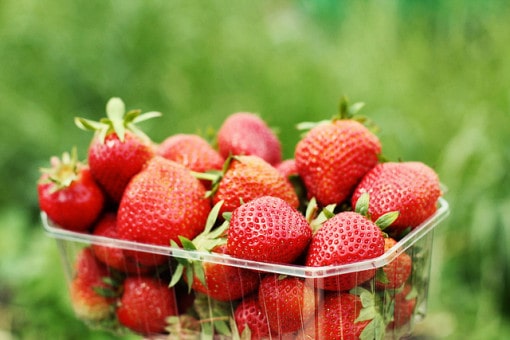Take a minute and think about how many plastic sandwich bags you have used over the years. That might be just what you need to realize why it’s important to figure out a way to eat in an environmentally friendly way. Every little change you make has the potential to make a huge difference. From grocery bags to water, there are a lot of ways that you can help clean up our environment and eat in a green and healthy way. Here are some ways in which you can still eat the foods you love but in a greener way.
Earth provides enough to satisfy every man’s need, but not every man’s greed.
– Gandhi
1. Reuse bags at the store. Next time you go to the store bring your own reusable bags with you. Every single year Americans use over 100 billion plastic bags which also costs us 12 million barrels of oil. These billions of plastic bags are piling up in landfills and are taking up massive amounts of space. Bring reusable bags and make a difference to this planet.
2. Strip down the products you use. Look for packaging that uses the least amount of materials that could fill up landfills. This is going to help the environment as there will be less amount of garbage.
3. Do not purchase plastic bottles. Landfills are overflowing with plastic water and soda bottles. Use tap water or large storage bottles to reduce your carbon footprint.
4. It is important to be mindful of the water that you drink as well as the food that you eat. Organic food is more environmentally friendly and does not add any chemicals to the drinking water.
5. Try to purchase locally grown produce. It is also extremely environmentally friendly because it creates less transportation energy which means less gas is used for trucking.
6. Eat a lot of what you buy. Try not to waste the food that you purchase. It’s good for the environment and your body. Over 40% of the food in the U.S. goes to waste and ends up in landfills. According to the Food and Agriculture Organization, over 1.3 billion tons of food ends up in landfills every single year.
7. If at all possible, eat foods raw. Not all foods should be eaten raw, but many vegetables can be eaten raw which saves energy on gas from your stone. It is yet another environmentally friendly way to keep you and environment healthy.
8. Make sure you are eating foods that are in season. This will ultimately save you on transportation costs. Some of the foods that are in season in Florida in January are oranges.
9. Try growing vegetables of your own. By adding potted plants or a small plot of vegetables, you can have easy access to fresh food which ultimately saves you a trip to the grocery store which saves you gas as well.
10. Eat less meat. Meat that has been industrially farmed has a great impact on the environment. If you can cut it out for good that is better. Meat that has been industrially farmed requires a lot of energy. Consuming less meat can help you to reduce your carbon footprint on the environment..
11. Make sure that the meats that you do eat do not contain antibiotics. Many farm animals that are raised for meat are given antibiotics which makes the meat unhealthy. Antibiotics and chemicals are not good for the animals nor the environment because they are putting chemicals where they are not needed.
12. If you eat fish on a regular basis then it is important to know your fish. You need to check guides to see which fish are endangered and which ones are not. You don’t want to eat endangered fish if you can help it. These are the standards set by the Marine Stewardship Council.
13. Make sure you are fishing for U.S based fish and continue to buy fish at local shops.
14. When it comes to foods that contain dairy, make sure you are purchasing products that are hormone-free. Make sure that the livestock was not raised on any type of hormones which are artificial and can cause negative impacts. This makes the ground water safer for all of us to drink. You can contact local businesses that can help you to find water that is hormone-free at a discount.
15. Just like with every other type of food, it is also best to go organic with your dairy products. It is not only good for your body but it is good for the environment.
16. Surprise, surprise…go local. Local foods are better for you and are less likely to have been pumped with hormones that can put you at risk health-wise.
17. Cutting back on cheese may sound impossible but it will help. The production of a pound of cheese can produce 11 pounds or more of carbon dioxide.
18. When you eat at a restaurant it is important to try and drink your beer and other beverages on tap. This cuts back on the garbage that is currently filling our landfills.
19. Support restaurants that purchase their products from locally-owned markets. These restaurants support local farmers and get most sustainable sources of produce and other food. It may sound like a difficult task, but there are many of them available if you simply ask.
20. Ask questions! It is okay to ask the restaurant manager or server how the food is cooked and where they get it from. If more such people do that, it may push the owner to get the raw products from natural and sustainable sources.
21. When you eat food at home you should use regular plates instead of paper ones, use cloth napkins instead of paper one, as well as for your utensils. You would be amazed by how much you are cutting back on by not using paper and plastic products when you eat.
22. Recycle your food. You can turn a lot of your waste into resources. You can turn food scraps into compost for your garden. There are a lot of options that are available that you can use to go environment friendly.
23. If you can make another meal out of leftovers then do so. You do not want to eat food that has gone bad, of course. You will be saving on the energy that it requires to cook the food.
24. Double up on your recipes so that your leftovers will last much longer. Depending on the type of food that was prepared, leftovers can last 3-5 days if they are kept in water-seal plastic containers and are properly stored.
25. Recycle your plastic, aluminum, and paper products. If you do not have a recycle pick up at your home take your recyclables to a facility. This will allow you to take more and re-use more. If you have your recyclables picked up then this saves you gas from having to do it yourself.

26. When you are packing your children’s lunches makes sure to use reusable containers instead of plastic sandwich bags. This will cut back on your waste.
27. Purchasing foods in bulk is a good way to cut back energy and gas as you will not have to travel to the store as often. It also creates less garbage in the landfills.
28. Using your own cup at the coffee shop cuts back on trash. Many popular coffee shops sell reusable cups you can buy or you can even purchase your own.
29. Keep a list of the foods you want to keep and the ones that you wish to throw out. Then you are able to create a shopping list that is more realistic which cuts down on what you buy. This ultimately cuts down on the food and trash that you are throwing out.
30. Purchase your pet food in bulk if you can. This will save on the trash that are putting in the landfills as well as save on energy and gas from the frequent commutes.
31. Avoid meat that comes from CAFOs. The trend of confined animal feeding operations (CAFOs) has lead to an abundance of cheap food, but not without serious health, ethical and environmental consequences, such as pesticide contamination, and soil, air and water pollution.
32. Cook at-least one “Local” meal per week. Give yourself a challenge and prepare one “Local” meal per week that is composed of local ingredients. Call in your friends or try organizing a potluck dinner from locally grown foods that could prove healthy for our environment. CAFOs are a major contributor to greenhouse gas emissions, water pollution and deforestation.
33. Join a CSA (Community-Supported Agriculture) Program. When you join a CSA program, you purchase a “share” of a farm directly from a farmer, and in return get seasonal produce each week throughout the farming season.
34. If you have lot of summer fruits and vegetables that you want to use before they get spoiled, try your hand in preserving them so they are available to you year-round.
35. As with produce, buying meat from local sources help you being environment friendly.
These are just some of the ways in which to save on your waste and help with the environment. It doesn’t take a lot of effort. With a few small changes in your life you can make a big difference in the environment.






